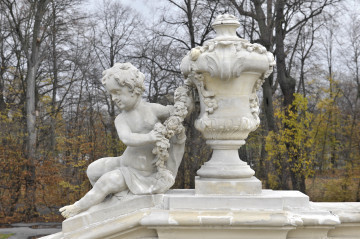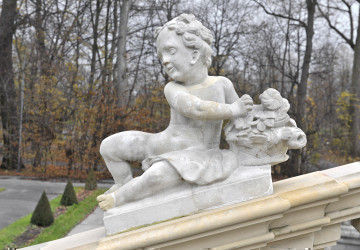
Putto with a vase
Museum of King Jan III's Palace at Wilanów
Part of the collection: Garden sculptures
The sculptures decorating the balustrade of the retaining wall and the stairs connecting the upper and lower terraces of the Baroque Garden are the most historically and artistically valuable sculptural elements of the Wilanów gardens. Their authorship is associated with one of the most outstanding representatives of the Warsaw Rococo sculpture, sculptor Johann Chrisostom Redler, and his workshop. They include the allegories of the Four Seasons, which can also be interpreted as the four stages of human life, made in Kunów sandstone, as well as four pairs of putti, symbolizing the Stages of Love, a pair of putti with sphinxes and flower baskets and vases. These themes which stem from the ancient era were one of the favourite themes in the late Baroque era. The number four, which characterizes both cycles, was considered the symbol of durability and universality of the material world. Therefore, it was used to recreate the spatial and temporal aspects of the universe. Hence the four directions of the world, four elements, four wind directions and four seasons. Both the four stages of love: Courtship, Kiss, Fear and Quarrel, as shown in the form of pairs of putti remaining in mutual, dynamic, expressive relationships, as well as the personifications of the Four Seasons, are subject to the relentless course of time, passing and changes, just like the surrounding garden. They are the reflection of the cyclically repeated periods both in nature and human life – from flowering to vegetation, from birth to death.
Autumn is shown in the form of a seated Bacchus, leaning on a decorative jug of wine. Bacchus (Dionysus) is one of the most important figures in Greek mythology. He is the god of wine and vine, also considered the protector of fruit trees and shrubs, the god of the fertile forces of nature by the Greeks. Feast in his honour were held several times a year, and the most important of them were the so-called Great Dionysia, celebrated at the end of March. Over time, these celebrations gave rise to the Greek tragedy and comedy. The works by Aeschylus, Sophocles, Euripides and Aristophanes, staged to this day, had their premiere during Great Dionysia in Athens. Therefore, Bacchus was also considered the patron of theatre and the performing arts. In art, Bacchus was shown in two ways, either as a mature man or as a beautiful young man holding a goblet of wine and a thyrsus (a long wand bound with grapevine and topped with a pine cone).
Agnieszka Świtek
Dimensions
entire object: height: 117,0 cm, width: 112,0 cm
Object type
scupture - full figure
Technique
sculpture
Owner
Museum of King Jan III's Palace at Wilanów
Identification number
Location / status

Museum of King Jan III's Palace at Wilanów

Museum of King Jan III's Palace at Wilanów

Museum of King Jan III's Palace at Wilanów
DISCOVER this TOPIC
Castle Museum in Łańcut
DISCOVER this PATH
Educational path